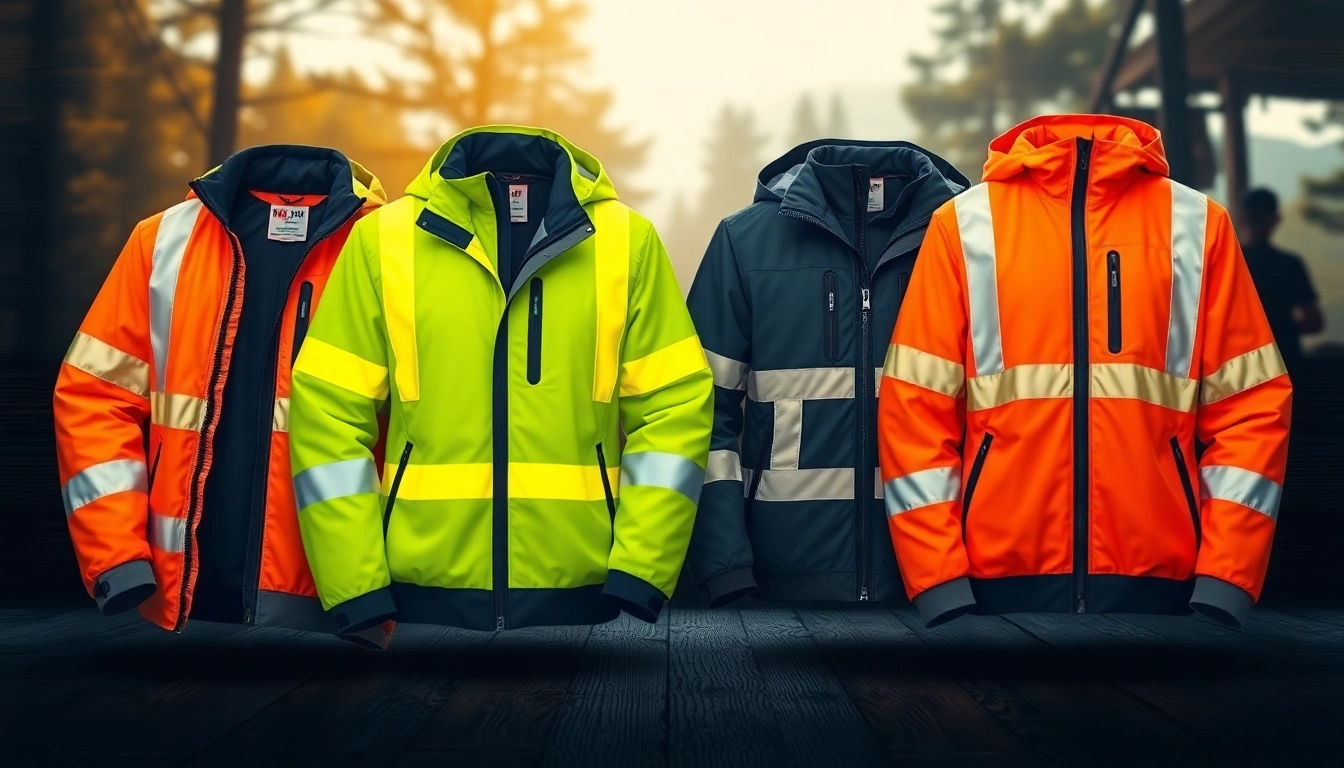The Importance of Reflector Jackets in Safety
In today’s fast-paced world, ensuring safety during low-light conditions or high-traffic environments is paramount. Reflector jackets serve a critical role in enhancing visibility and preventing accidents. Whether you are an outdoor worker, a cyclist, or simply someone who walks in dimly lit areas, wearing a reflector jackets can significantly increase your safety. Not only do these jackets protect against environmental elements, but they also catch the eye of motorists and others, significantly reducing the chances of mishaps.
Understanding the Functionality of Reflector Jackets
Reflector jackets are designed to reflect light, typically from vehicle headlights, through reflective materials integrated into the jacket’s fabric. This reflection enhances the visibility of the wearer significantly. The core functionality lies in the materials used, which are strategically placed to maximize exposure and reflective coverage. The most effective jackets utilize advanced reflective technologies capable of bouncing back light in a 360-degree radius, allowing individuals to be seen from various angles.
Key Benefits of Wearing Reflector Jackets
Wearing a reflector jacket offers numerous benefits:
- Enhanced Visibility: The primary advantage is improved visibility during low-light conditions, such as dawn, dusk, or nighttime.
- Accident Prevention: Increased visibility leads to fewer accidents as others—drivers, cyclists, and pedestrians—are more likely to see you.
- Weather Resistance: Many reflector jackets are designed to withstand adverse weather conditions, providing additional protection against rain, wind, and cold.
- Comfort and Breathability: Modern reflector jackets often use breathable materials that offer comfort during various activities without compromising safety.
- Style Versatility: With various designs available, reflector jackets can be worn in casual or professional settings, ensuring the wearer looks good while being safe.
Regulatory Standards for Safety Compliance
Regulatory bodies have established standards that reflector jackets must meet to ensure they are suitable for occupational safety. In the United States, for instance, the ANSI/ISEA 107 standard outlines the minimum requirements for high-visibility garments. These standards dictate the colors, materials, and reflective properties required for jackets to be certified as adequate safety gear. Adhering to these regulations is essential, particularly for those in professions such as construction, road maintenance, and emergency response.
Types of Reflector Jackets Available
Reflector jackets come in various styles and functions tailored to different industries and activities. Understanding the types available can aid in selecting the appropriate one for your specific needs.
High Visibility Options for Various Professions
Different professions have varying requirements for visibility and safety. For example, construction workers often wear heavy-duty reflector jackets that adhere to ANSI standards, featuring bright colors like fluorescent orange or yellow. On the other hand, cyclists may opt for lighter, more flexible styles that allow for comfortable wear without compromising the level of visibility needed on busy roadways. Additionally, emergency services personnel require jackets designed for rapid deployment and high visibility in crisis scenarios.
Casual vs. Professional Style Reflector Jackets
Reflector jackets are not limited to high-visibility workwear. Casual styles are available, designed with everyday streetwear in mind. These jackets maintain the reflective properties necessary for safety while presenting a more fashionable appearance. They typically combine functionality with style, allowing individuals to wear them in a variety of social settings without looking overly utilitarian.
Weather Adaptability in Reflector Jackets
Weather adaptability is a crucial consideration when selecting a reflector jacket. Many are constructed with materials that provide waterproofing, breathability, and wind resistance. Some jackets are also insulated for warmth, making them suitable for various climates and conditions. When choosing a jacket, it’s essential to consider where and when it will be used—ensuring it’s appropriate for the weather you are likely to face.
Choosing the Right Reflector Jackets for Your Needs
Selecting the right reflector jacket involves several factors, from fit and comfort to style and function. Here’s what to consider:
Determining Fit and Comfort
The first step in choosing a reflector jacket is determining the appropriate fit. An ill-fitting jacket can hinder movement and reduce comfort, especially if worn for extended periods. Ideally, your reflector jacket should allow for free movement and be flexible enough for your activities, whether you’re walking, cycling, or working. Pay attention to sizing charts and consider trying jackets on if possible to gauge how they feel and fit before making a purchase.
Selecting the Appropriate Color and Style
Color choice plays a vital role in the effectiveness of reflector jackets. While bright colors increase visibility during daylight, reflective materials are essential for nighttime visibility. Therefore, a combination of both is necessary for maximum safety. Consider the environment in which you will be using the jacket—urban settings may benefit from chic designs that blend professional aesthetics with safety, while rural environments may prioritize high visibility over style.
Assessing Function vs. Fashion in Reflector Jackets
When choosing a reflector jacket, it’s crucial to balance function and fashion. While the aesthetic of the jacket may be appealing, its effectiveness at providing visibility and protection should always come first. Look for jackets that incorporate reflective elements seamlessly into their design, making them suitable for multiple situations, whether at work or during leisure activities.
Maintenance and Care for Reflector Jackets
Cleaning Guidelines to Maintain Visibility
Cleaning your reflector jacket appropriately is critical to preserving its reflective qualities. Most jackets can be machine washed, but it’s essential to check the manufacturer’s instructions regarding temperature and detergents. Avoid using bleach or fabric softeners, as they can damage the reflective material. Instead, opt for mild detergents and gentle settings to keep your jacket in optimal condition.
Storage Tips for Longevity
When not in use, store reflector jackets in a cool, dry place away from direct sunlight. Prolonged exposure to harsh UV rays can diminish the reflective properties. Hanging the jacket on a padded hanger can help retain its shape while preventing creases or folds that could damage the fabric over time.
Identifying Wear and Tear Signs
Regularly inspect your reflector jacket for signs of wear and tear, such as fraying seams, fading reflective materials, or other structural issues. Any deterioration in visibility effectiveness could pose safety risks. If your jacket shows significant wear, it’s advisable to invest in a new one to maintain optimal safety levels.
Innovations and Trends in Reflector Jackets
The field of safety apparel continually evolves, with innovations improving functionality, comfort, and aesthetic appeal. Keeping up with these trends can help you select the most effective reflector jackets available.
Technological Advances in Reflective Materials
Recent advancements in reflective materials have led to more effective and durable options for jackets. Innovations include improved fabric breathability, lightweight construction, and enhanced reflective capabilities that remain effective even after multiple washes. Other materials are being developed for better weather resistance, which is essential for outdoor workers and individuals in varying climates.
Customized Designs: Beyond Basic Reflector Jackets
Today, customized reflector jackets are gaining popularity—allowing individuals and organizations to incorporate logos or personal designs while retaining essential safety features. This customization enhances brand visibility and provides an opportunity for companies to promote their commitment to safety. Options for custom prints, colors, and styles offer versatility in how reflector jackets can be presented.
The Future of Safety Apparel
The future of reflector jackets and safety apparel looks promising, with a focus on sustainability, functionality, and aesthetic appeal. As environmental awareness grows, new materials are being developed to create eco-friendly jackets that maintain quality without harming the planet. The integration of smart technology into reflective garments, such as GPS integration or build-in light indicators, may also emerge as a revolutionary trend in enhancing safety on the roads and job sites.



